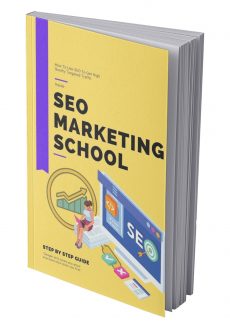 License Type: Master Resell Rights
License Type: Master Resell Rights  File Type: ZIP
File Type: ZIP
 SKU: 64035
SKU: 64035  Shipping: Online Download
Shipping: Online Download
Sample Content Preview
Chapter 1: Introduction
With social media and online activity taking over our lives, it has become a necessity for businesses to work on the many strategies that make their online presence effective.
Companies now work on employing professionals whose entire job is to come up with different tactics that help businesses increase their online traffic. This traffic is, more often than not, dictated and redirected from search engines like Google. And to please them, search engine optimization has become a fundamental part of the operation.
Now, a lot of this redirection of traffic is meant to happen organically. If you are a tech-savvy individual who is able to keep up with the changes in the many algorithms employed by search engines, you will be able to make sure (to some extent) that your website never falls off the radar of said search engines.
Strategies that involve such organic ways of building traffic are also a preferred technique no matter what kind of website you run because these strategies bring more customers naturally to the product or service a business offers.
The alternative is engaging in paid advertising which is nothing to frown upon but in comparison, it does not guarantee as high a conversion rate in the long run compared to as organic strategies to build traffic.
This is apart from the fact that paid advertising is usually marked as such on the internet and when people realize it is an ad, they are highly demotivated from clicking on whatever is in front of them. This means that it takes a lot more work to get your viewers to engage with paid advertising.
One way to increase incoming traffic to any website is to engage in search engine optimization. Research has shown that this increases your website’s chances of growing traffic by 20 times when compared to paid advertising whether you look at the numbers on a desktop or a mobile.
Sidebar—it is important to make that distinction in terms of devices. I will cover that in detail at a later point.
SEO strategies are not just a practical way of getting more attention from search engines but are also a marketing strategy that continues to reward you over time. The only thing you need to remember is to stay up to date with the ever-changing rules and regulations set forth by some of the big names in the search engine community.
This includes keeping tabs on including the correct keywords for every bit of content you publish on your website because these keywords help search engines give your page the high ranking it deserves.
This ranking plays a big role in the order in which search results are displayed for any given user query. This, in turn, gives your website the visibility you are shooting for.
Make your content interesting and relevant and over time you will see that something as simple as adding the right keywords will help your traffic skyrocket. In comparison, paid advertising needs to be funded continuously and doesn’t always guarantee the results you hope for.
But this is not just about strategy. Including the right keywords essentially started off as a way to tell the search engine what your content is about and how it should be indexed.
It was an efficient way for the likes of Google to categorize your content when a user is looking for similar information. While that is still valid in theory, many more developments have taken place in the space of search engine optimization and I will go over them all in this book.
But before that, a question that every new business, especially the small- and medium-sized ones ask themselves is if they need to hire a specialist to get this part of the job done.
The first thing you need to consider is the time and effort you are willing to put in. It also depends on how complex a website you are going to run. If it’s not an elaborate one, you can start off by doing some basics yourself.
If you do have expansion plans, it doesn’t hurt to consult an expert or hire an agency to get there. The quality of services provided by them are different in terms of scale and quality. So, you need to know a few things before you know which one is good and right for your operations. I will go through that too at a later stage in this book.
Among the many basics you need to know are the fundamentals of how search engine optimization works. For that, you need to understand the parameters the existing search engines like Google and Bing use to rate your website.
Every search engine uses crawlers to gather information about the content on the internet. These crawlers come back with binary data (in 0s and 1s) that helps the search engine make an index. This index goes through an algorithm designed by the search engine and checks to see if your website matches the query entered by a user.
When you optimize your website for a search engine, what you are doing is making sure that the content on the website has all the requisite information and metadata that any person who is looking for such information is likely to type into the search bar.
This metadata includes the right title, description and tags that are relevant to the corresponding content. This needs to be relevant and informative. Let’s dig a little deeper into that.
Chapter 2: What Is SEO?
SEO, as mentioned before, stands for search engine optimization. When you practice SEO, what you do is make sure the quality and quantity of the content on your website is channeled towards increasing the traffic on your website.
This is meant to give it more visibility and also expose your brand to as many potential customers as possible. This is an organic way of getting better results when someone looks up information you might have.
It is a critical part of marketing your product or service on the internet because trillions of searches are being conducted on the internet every year and there are an innumerable number of websites that are competing with you to get the same set of eyeballs.
A lot of these are commercial operations and searches are a big part of how users find brands and their services. When you do a good job with search engine optimization, your website gets better rankings for keywords/keyphrases from the search engines and that improves your brand’s visibility. This gives you a very real shot at converting a regular visitor to the website into a paying customer.
This is no longer the open secret that it used to be a few years back. This means businesses have gotten good at tricking search engines to rank their webpages higher to get visibility. So, search engines are constantly tightening the screws by changing the parameters through which they rank websites to make the search results more useful to the user instead of benefiting businesses with subpar content. This is why you need to be on your toes and in the loop on new practices.
Search engines are also trying to retain traffic on their search results pages instead of redirecting users to other webpages because advertising is how they make their money. This is why you see certain features on the homepage.
Think about this. The search engine results page or SERP has both ads and organic results. One such feature is the featured snippet, also referred to as the answer box. There are also image carousels that do the same thing except they are for pictures. This feature gives the user a direct answer to a specific question instead of redirecting them to a different webpage.
So, if the user types “London weather” or “convert cm to inches” or “Sydney time now”, they won’t just be given a list of websites or be taken to a website that answers the question. They see a box that answers the question or in the case of a conversion, allows them to enter the numbers and get the results right away. You will also notice similar boxes for queries that can be answered by sites like IMDb and WebMD.
Search engines are able to make money more efficiently when they cater to the users’ needs by keeping them on the SERP pages for a short period of time (it might be confusing, but this means that the user found what he was looking for in short time).
But lucky for businesses, some of this can be beaten fair and square with good search engine optimization techniques. This can be done for paid and organic content. That’s how when a user types a direct question into the search panel, they get a brief summary of text from the highest-ranking page which possibly answers the question right away. This could be an organic result based on good SEO.








